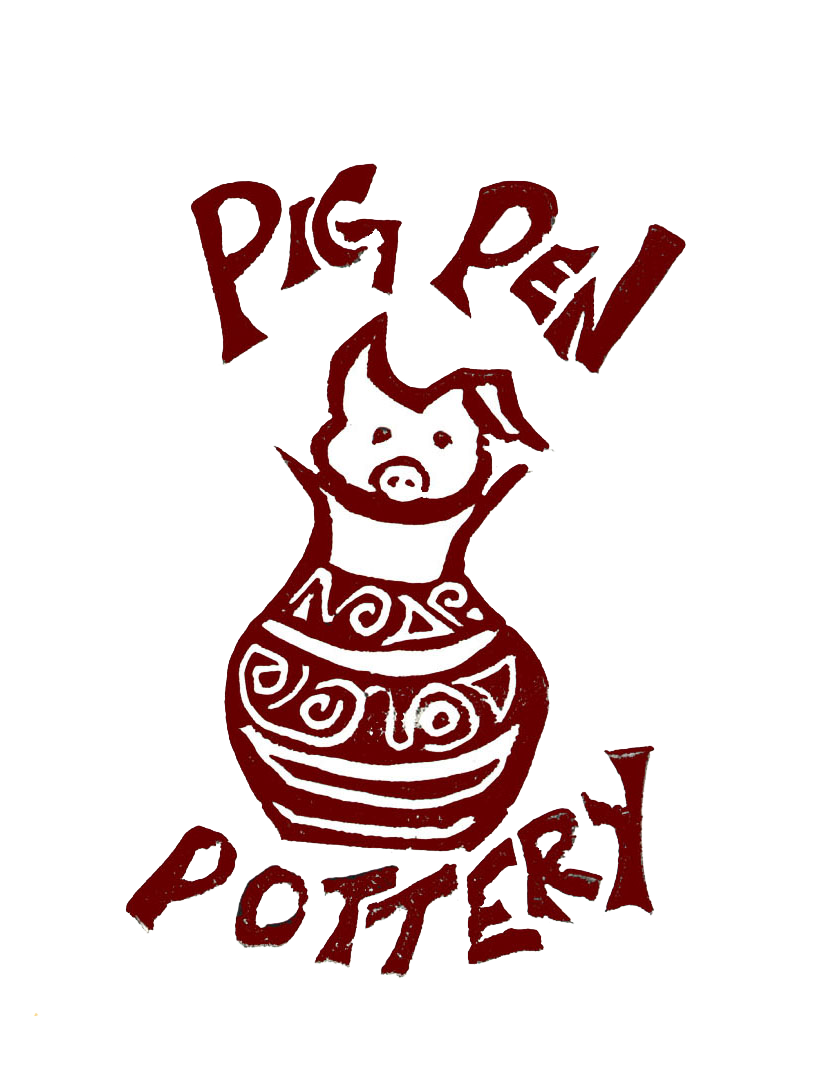About Laura
I work in my home studio, Pig Pen Pottery, on my family farm, Hidden Springs Farm, in Great Falls, Va. I make functional stoneware pieces for the kitchen and the table, stoneware lamps, fountains and masks. The stoneware is fired in a reduction gas kiln. Seasonally, I work in Raku, pit firing, saggar firing, and alcohol reduction.
My goal is to make a pot that is pleasing to the eye, to the hands and to the purpose for which it is intended. The measure of success for me is hearing that someone uses my mug specially for hot chocolate, for instance, or my bowl for ice cream. We are so accustomed to having all matching plates, bowls and cups that we risk becoming insensitive to our tableware.
About Hidden Springs Farm
I am fortunate to be still living on the farm where I grew up, raised my children, saw my grandchildren grow, welcomed many family reunions, celebrations, weddings and holiday gatherings. I share the farm with 4 goats, chickens, guinea fowl, 2 dogs, foxes, raccoons, coyotes, owls, my husband, Charlie, and my children Shep, Tote and Jenny, my daughters-in-law, Tara and Kathy, my son-in-law, David, and grandchildren, Morgan, Nate, Autumn, Tobey, Laura, Charlie, and Josephine.
The chickens land as decoration on my pots as do the guineas, goats, foxes, herons, owls, and whatever else I can persuade the brushes to deliver.
I have been making pots for over 40 years. I am self-taught, leaving me to wonder on occasion whether I have a genius or an idiot for a teacher. I have learned that being a potter requires optimism and the subtle art of persuasion. Every pot and every firing teaches me to observe and appreciate the laws that dictate the behavior of the clay and the fire.
Making pottery is an exercise in letting go. Rarely does a pot come out as expected. The best you can do is combine shape, texture and color according to your muse, and then give it over to the fire. Accepting the unexpected is singularly difficult to those of us who harbor delusions of control. Firing Raku is the essence of this truth. What the fire gives you is what you get!
My formal education is Anthropological Linguistics (PhD, The American University 1988.) My dissertation, (The Prefix in Isletan Tiwa, Laylin, 1988) has to do with the way language structure determines what we can and can not say in our language, which is a product of the cultural environment in which it is spoken.
Hidden Springs Farm – a very brief history
The land that now carries the name Hidden Springs Farm was first patented to a Vestryman from Truro Parish (now Alexandria) named Edward Emms, in 1731. From then until 1851 it was owned by local families who farmed the land as subsistence farmers primarily with a cash crop of tobacco on the side. The farm was called Mount Pleasant until the Revolutionary War years when its name was changed to Montpelier, no doubt following the Francophile mood sweeping the states, and James Madison’s lead.
The land became so impoverished by the cultivation of tobacco that the local farmers were content to part with it cheaply. Northerners, with advanced ideas of chemical fertilization, crop rotation and other “scientific farming practices” were able to bring the land back into profitable production.
During the Civil war, this area was ravaged as first one army and then the other passed through taking what they needed. The men were mostly off at war. The women pledged allegiance to whichever army was camped in the back field at the time. James Harvey Sherman lived at Montpelier during the war years. He was a Union spy and a detective in Lafayette Baker’s Secret Service. He and his men captured $18,000 worth of contraband and the men who were bringing it across the lines.
In the middle of the night on April 20, 1863 Sherman was captured by John Mosby, the Gray Ghost, from the safety of his farm. According to the Alexandria Gazette, he was “summarily executed and his remains were returned to his family.” However, a few days later it was reported that the eyewitness report was in error. Sherman did spend time in Salisbury Prison before relocating to Michigan where he and his wife Melosany had three more children for a total of eleven.
Following Sherman at Montpelier were a fellow Union Soldier named Horace Payne, and Joel Craven, a farmer from Loudoun County who farmed here until he sold the place to Grote Hutcheson in 1908. Hutcheson was a General in the Army who despite his fondest wishes never escaped war long enough to settle here.
My father, John Laylin, a lawyer, bought the farm in 1939, named it Hidden Springs, and farmed it (cattle) until his death in 1979. My husband Charlie and I continued raising cattle until 1990 when it became apparent that it was too expensive and potentially dangerous to have cattle in suburbia. We now operate as a forestal district, concentrating on native plants and wildlife support management. By this I mean that the deer destroy everything that Charlie plants and the foxes feed happily on my hens!








